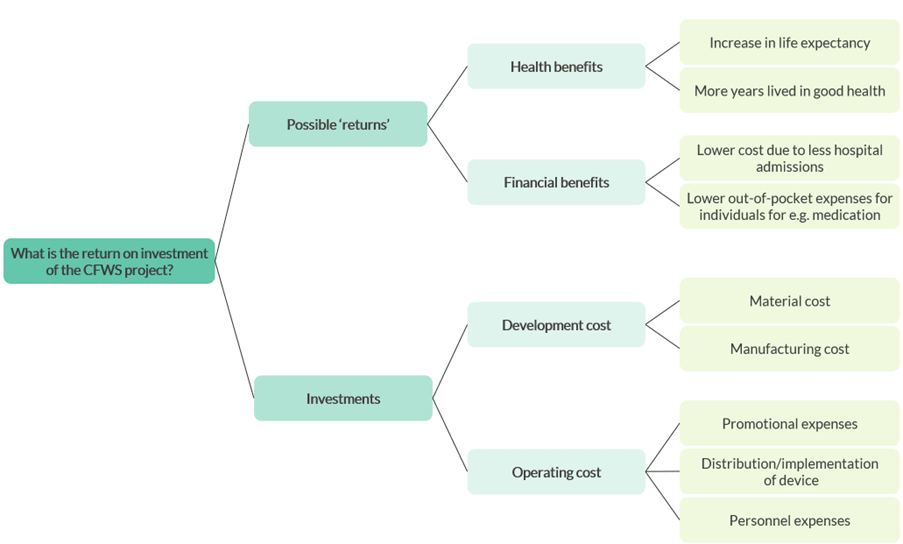

Finished? Let's see how you did.
Remember: there is no right or wrong answer. The goal for us is to see how you arrive at an answer, not the answer itself.

Answer 1
An example of a good answer should contain the following aspects:
1. Think of how the return on investment be qualified and quantified: both cost and benefits must be compared. 2. The cost can be defined as cost for development of the tool, distribution cost and promotion cost.
Additionally, you must think of the benefits involved. A few examples of benefits that you could have thought of are:
• Less occurrence of diseases caused by drinking polluted water and thus and an increase in life expectancy.
• A decrease in hospital admissions: nowadays, approximately half of the hospital beds are occupied with people that are sick due to drinking unsafe water.
• A reduction of hospital costs: it is estimated that about 12% of healthcare costs are spent on the treatment of diarrhoea.
Possible issue tree


Answer 2
Some risks that could be considered: • Lack of support and uptake by the society and (local) government.
• Measuring the effect on a potential decrease of the occurrence of diseases and disease related deaths of this project can be difficult. This is due to other factors that can result in the same type of diseases. Think of proper hygiene, sanitation, and sewer installation.
• Other initiatives, like new medication, could make the benefits of the device superfluous.
Answer 3
The number of episodes prevented can be calculated as follows:
Number of episodes prevented = Total target population x Incidence rate x Success rate of the treatment = 10,000,000 x 1.05 x 0.3 = 3,150,000 episodes.
Answer 4
To answer this question the result the project needs to be evaluated. The benefits can be given in terms of DALYs. It is useful to make a distinction between the different terms; YLL’s, YLD’s and DALY’s.
Start with stating the steps needed to calculate the years of life lost (YLL) that are saved:
YLL = Mortality of the diseases x Number of episodes prevented x Years of life lost in case of a fatal episode:
• Mortality of the diseases = Deaths because of an episode/Total amount of episodes = 500,000/1,000,000,000 = 0,05%
• The number of episodes = 3,150,000 (see answer to question 3)
• Years of life lost in case of a fatal episode = Life expectancy at birth – average age of death in case of a fatal episode = 62,5 - 2,5 = 60 years
>> For the average age of death, it is perfectly fine to make an assumption based on the three countries’ specific numbers.
YLL = 0,05% x 3,150,000 x 60 = 94,500
Secondly, the years lived with disability (YLDs) can be calculated:
YLD = Number of disease episodes prevented x Average duration of an episode (in years) x Disability weight factor:
• The number of episodes = 3,150,000
• The average duration of an episode = 2/52 ≈ 0,04 years
• The disability weight factor = 0,2
YLD = 3,150,000 x 4% *x 0,2 = 25,200
At last, the disability adjusted life years (DALYs) are calculated:
DALY’s in total = YLL + YLD = 94,500 + 25,200 = 119,700

Tips to practice more cases
Want to practice more cases? Check out preplounge.com, become a member of the 'FSA Consultancy Club' facebook group, practice with acquaintances who have already applied to a strategy consultancy firm or read books such as 'case in point'. Good luck!

Answer 5
In addition to the DALYs from question 4, the total investment needs to be calculated:
Total investment (EUR) = Donation + DCWF + Third parties = (100,000+72,000+24,000) + (44,000) + (60,000) = 300,000 EUR
Using the DALYs and the total investment, it is possible to get the DALYs saved per euro:
DALYs saved per euro = DALYs / Investment = 119,700/300,000 ≈ 0,4
A good candidate would argue that 0,4 DALYs’ saved per euro is a high number. With 2,5 euros spent on the project someone will live an extra year.
A good answer to argue whether the project is worth the investment, would at least contain the following aspects:
• The project seems very successful, so it is a logical step to apply it in on a larger base in these three countries or expand it to other countries.
• When expanding or enlarging this project, there can be some possible problems on the road. There could be more interference by governments, or places that don't have the CFWS right now might be harder to reach with all the equipment needed for the CFWS.
Examples of aspects that can be considered to expand the project are:
• There is often little support from the local government in implementing such big changes. However, support from the government could have a great positive effect on the implementation opportunities.
• Raise more awareness to possibly receive more donations or engage in collaborations with other organisations.
• Investigate the future impact of implementing the system. This can result in a greater support base.
Keep in mind that these are just examples of correct answers. Other answers might be correct as well, as long as the answer contains elements for and against the expansion.
Answer 6
A possible answer could be: The project seems to have a high return on investment. For every euro spent on the project, someone can live an additional 0,4 years in good health. The benefits of the project are the number of episodes of diseases the project prevents. This results in people living longer and living longer in good health. The next step would be to expand the project such that more people could benefit.
A good candidate will also go back to his framework that was made at the start of the case. This can be used to make sure all elements are captured in the advice or at least mentioned to be left out of scope in the advice.

We hope you've enjoyed the case!
Feel free to let us know if you have any feedback.
